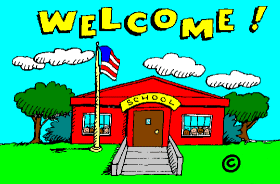
http://www.school.discovery.com/clipart/clip/ani-schl.html

http://www.school.discovery.com/clipart/clip/ani-schl.html
This is an activity that will encourage your fourth or fifth grade students to be creative inventors. This assignment involves coosing an odd gadget and then, within small groups, brainstorming ideas for new uses. By the end of the project, students will have gained experience in the use of digital cameras and specific computer programs, creating linked web pages, and writing creative as well as persuasive articles/advertisements.
MATERIALS NEEDED:
PROCESS:
E-MAIL is how the teacher will be giving feedback to each student. This needs to happen at least once during the assignment, but more is recomended to offer encouragement and suggestions. Teachers may also give final grades via e-mail.
Stress the importance of citing all work and images!!! This will be part of the grade!
*There is software and accessories available for those students in your classroom that have special needs. This includes learning and physical disabilities. Changing the settings will often be helpful to those children as well. You can change the background color, contrast of lighting, and change from using the mouse to the keypad.
To view and example of this activity, click here.
RUBRIC for grading activity:
|
|
|
|
|
| Group Work | Doesn't cooperate with other group members or participate in brainstorming ideas or in taking pictures | Cooperates somewhat with other group members but is not actively involved in brainstorming ideas or in planning | Fully cooperative with other members in brainstorming ideas, taking pictures,and planning |
| Article | Many grammar, punctuation, or spelling mistakes. Unclear wording and target audience. No detail. | Some grammar, punctuation, or spelling mistakes. Needs some work on clarity. Little detail. | Well-written, clear article with no grammar, puntuation, spelling mistakes. Lots of detail. |
| Photos | No images used | Unclear photos | Thoughtful use clear of images. |
| Web Page | No web page or one that lacks minimal requirements. No images are cited. | Web page has obvious problems with organization and/or technical isues. Some images are cited. | Well-organized web page that displays knowledge of technical issues. All images are cited. |
Computer Skills met:
Grade 4
1.3 Identify violations of the Copyright Law. (SI)
1.4 Recognize the correct use of copyrighted materials in multimedia
products. (M/P)
1.5 Identify the need for Acceptable Use Policies (AUP). (SI)
2.1 Use technology tools used to collect, analyze, and display data.
(SI)
2.9 Use e-mail as a means of communication. (T)
2.10 Use search strategies to locate information electronically. (T)
2.11 Recognize the differences between non-networked and networked
computers. (SI)
Grade 5
1.1 Recognize the influence of technology on life in the United States.
(SI)
2.1 Use technology tools to collect, analyze, and display data. (SI)
2.2 Explain the differences between a non-networked and networked
computer. (SI)
3.3 Select search strategies to obtain information. (DB)
Information Skills met:(for both grade
levels)
1.07 Follow acceptable use policy (AUP/IUP) for electronic resources.
1.10 Identify characteristics and advantages of various media formats
(print, graphical, audio, video, multimedia, web-based) for a specific
task.
2.06 Recognize the power of media to influence.
4.06 Comply with the Copyright Law (P. L. 94-553).
4.07 Organize and use information.
4.09 Present information in a variety of formats (print, graphical,
audio, video, multimedia).
5.02 Produce media in various formats (print, graphical, audio, video,
multimedia) appropriate to audience and purpose.
5.03 Collaborate with others, both in person and through technologies,
to identify information problems and to design, develop and evaluate information
products and solutions.
5.04 Credit sources in all print, non-print, and electronic products.
Language Arts Competencies met:
Grade 4:
3.03 Consider the ways language and visuals bring characters to life,
enhance plot development, and produce a response.
4.03 Make oral and written presentations using visual aids with an
awareness of purpose and audience.
4.05 Use planning strategies to generate topics and organize ideas
(e.g., brainstorming, mapping, webbing, reading, discussion).
4.10 Use technology as a tool to gather, organize, and present information.
5.01 Use correct capitalization (e.g., names of languages, nationalities,
musical compositions) and punctuation (e.g., commas in a series, commas
in direct address, commas and quotation marks in dialogue, apostrophes
in possessives).
5.09 Create readable documents through legible handwriting and/or word
processing.
Grade 5
2.10 Identify strategies used by a speaker or
writer to inform, entertain, or influence an audience.
4.03 Make oral and written presentations to inform
or persuade selecting vocabulary for impact.
4.05 Use a variety of preliminary strategies
to plan and organize the writing and speaking task considering purpose,
audience, and timeline.
4.10 Use technology as a tool to enhance and/or
publish a product.
5.01 Consistently use correct capitalization
(e.g., names of magazines, newspapers, organizations) and punctuation (e.g.,
colon to introduce a list, commas in apposition, commas used in compound
sentences).
5.04 Determine the impact of word choice on written and spoken language.
5.07 Edit final product for grammar, language conventions, and format.
5.08 Create readable documents through legible handwriting and word
processing.
Want to see the master
page?
Click here
to view student insructions
Hints
for getting space on a web server.